This was published 5 years ago
Sicily, Italy: The most beguiling island in the Mediterranean
By Ute Junker
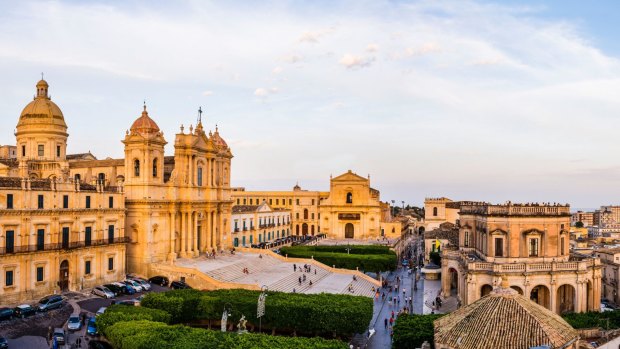
The Piazza del Municipio in the picturesque town of Noto, Sicily.Credit: Alamy
The best thing that ever happened to the town of Noto was its total destruction. The great earthquake of 1693, which devastated much of south-western Sicily, flattened Noto so completely that a decision was taken to rebuild the town on a new site, 14 kilometres away. The architects assigned to the task did more than just bring a city back to life; they created a baroque masterpiece. On an island filled with picturesque towns, Noto takes the prize.
Noto might be small but it is a town conceived on a grand scale. It has just three main streets, but no fewer than three grand squares, along with an array of churches and palazzi that would do many a larger town proud. All the buildings are made of the local volcanic rock, tufa, which glows warmly in the sunlight. No wonder that the entire town centre has been recognised with a UNESCO World Heritage listing.
The town's centrepiece, its monumental cathedral – accessed via a grand triple-tiered staircase – is famous throughout Italy because of another stroke of bad luck. During a thunderstorm in 1996, the cathedral's mighty dome collapsed. It took 10 years to restore the building to its current pristine condition.
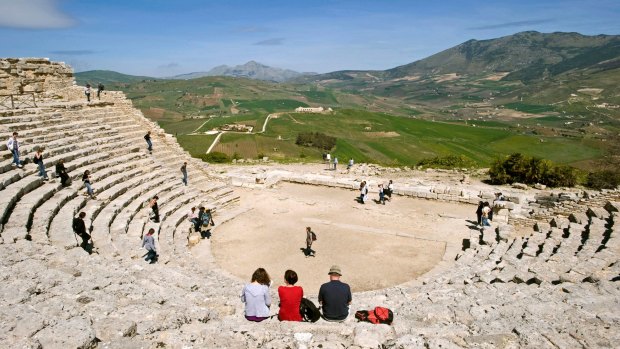
Segesta archeological site: Antic theatre built in the 3rd century BC.Credit: Alamy
The cathedral is not the only building worth a closer look. The church of Santa Chiara, located across the way, is more compact than its neighbour but its unusual oval interior and its ornate decorations, done in a restrained black and white palette, are eye-catching. However, the most remarkable thing about Santa Chiara can be found by heading up the staircase that is tucked into one corner of the church. It leads to an unexpected roof terrace that offers a magnificent panorama of the town centre.
Noto's beauty extends well beyond the town's main drag. Take a stroll down some of the side streets and you will find palazzi and townhouses richly decorated with Sicilian baroque. Doors and windows are framed with elaborately carved scrolls, cupid heads and abundant piles of stony fruits and flowers. Wrought iron balconies are supported by stone brackets carved to resemble lions heads, or ancient gods, or rampant horses.
Noto may do a nice line in grandeur – it even has its own triumphal arch – but its small-town feel is an integral part of its charm. Life here unfolds at an unhurried pace. Priests stop in at the local cafe for a cappuccino, where they are greeted by black-clad nonnas snacking on pistachio tarts; locals stop for a chat with the shopkeepers who are keeping a proprietary watch on the goings-on in the street.
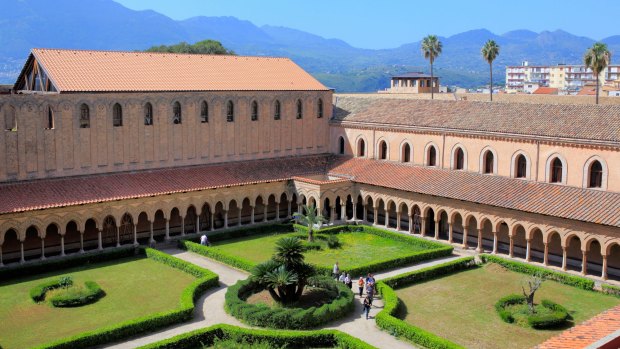
Cloister of Monreale Cathedral.Credit: Alamy
MEET THE BIG GAME HUNTERS
Noto's phoenix-from-the-ashes tale is not Sicily's only great survival story. Its renaissance was shared by other nearby towns that also suffered in the earthquake; Ragusa, Modica, Catania were all also rebuilt as baroque beauties. In fact, death and rebirth seem to be constant themes in Sicily, an island where, over 3000 years, many of the Mediterranean's great civilisations set up new towns and cities, or reinvigorated old ones. The Phoenicians, the Greeks, the Arabs and the Normans were just some of those who settled in Sicily, drawn by the island's fertile soils and strategic position.
Naturally, the Romans also made their way here. The island was one of Rome's most important provinces, supplying much of the grain that fed the world's greatest city. Compared with mainland Italy's wealth of theatres, temples and baths, Sicily has a surprisingly small trove of Roman ruins. However, at least one of its Roman sites rivals anything on the mainland. The Villa Romana del Casale, outside the town of Piazza Armerina, has scored a World Heritage listing for its extraordinarily vivid and well-preserved mosaic floors. Like Noto, the mosaics were saved by a disaster: a landslide covered the villa 900 years ago, preserving the floors beneath the tons of soil.
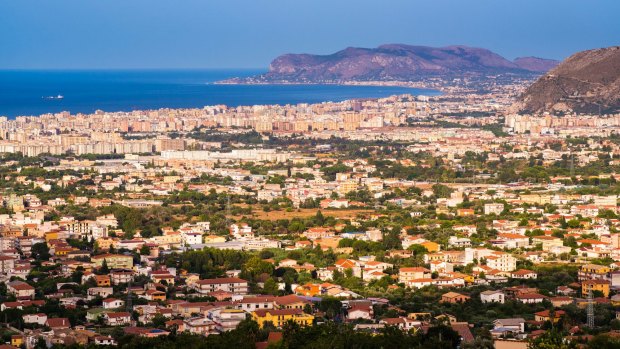
Palermo seen from Monreale.Credit: Alamy
These are not your average mosaics. Dating back to the 4th century AD and stretching across 3500 square metres of floor, these dazzling images have no equal anywhere in the Mediterranean. Every room is different. Perhaps the most surprising images are the so-called bikini girls. Clad in two scanty pieces of fabric, their midriffs and limbs bare, these young women are not bathing beauties, but athletes practising a range of sports, including discus throwing and ball throwing. Despite countless trips to Italy and plenty of time spent visiting Roman ruins, I've never seen anything like them.
The bikini girls are not the highlight, however. That honour goes to the spectacular mosaic known as the Great Hunt. It is a detailed depiction of hunters capturing exotic animals, including a hippo, an elephant, tigers and leopards, all animals typically used in gladiatorial spectacles.
The mosaic is as action-packed as an Avengers movie. We see a boar trussed to a pole, carried by two hunters, and a rhinoceros being dragged out of the swamp. Elsewhere, leopards and tigers savage their prey. A range of creatures are captured and taken aboard a ship, some in crates, while one man carries an ostrich in his arms.
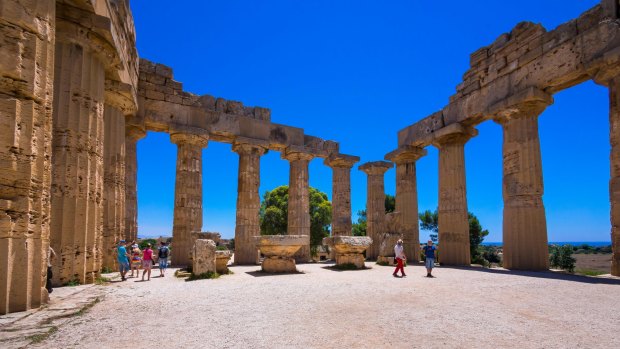
Temple of Hera, Marinella.Credit: Alamy
The identity of the villa's owner remains a mystery. Clearly, he was immensely wealthy. "He may have been an entertainment impresario who exported African animals to Rome, a Roman Bernie Ecclestone," explains our guide, John McNeill. McNeill has a way with words. His day job is at Oxford University's Department of Continuing Education, but he also leads a number of itineraries for Martin Randall Travel, including our 13-day Civilisations of Sicily, and has insights to offer into every remarkable sight that we encounter.
TAKING THE SLOW ROAD
John McNeill's commentaries are one of the great delights of this tour. Another is the relaxed pace. Over 13 days we base ourselves in just three towns: Palermo, Taormina and Siracusa. Not only does that slash the amount of unpacking and repacking involved, it also keeps the touring pace fairly relaxed. And if you are interested in one particular civilisation – say, the ancient Greeks – there is something new to discover at every stop.
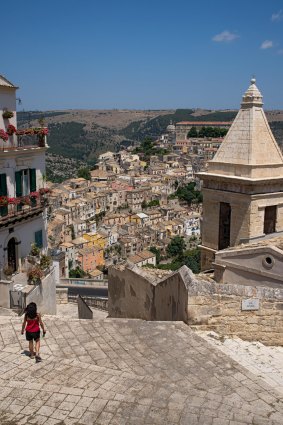
Cityscape in Val di Noto.Credit: Alamy
From Palermo, we visit the Greek temples at Segesta and at Selinunte, with its atmospheric coastal location, as well as the World Heritage-listed collection of temples at Agrigento, which date back to the 6th century BC.
At Agrigento, the temples stand in splendid isolation outside the town. Elsewhere on the island, Greek ruins are surrounded by newer settlements that have grown up around them. Take the city of Siracusa, the mightiest of the Greek states' many colonies. At its peak, Siracusa challenged the power of Athens herself. Centuries later, under the Romans, the city was still flourishing; Cicero described it as one of the largest and the fairest cities. Today Siracusa remains one of Sicily's key centres, but ancient theatres and quarries can still be found amid the modern roads and high-rises.
Perhaps Siracusa's most interesting Greek relic, however, is hidden in plain view. Head to the atmospheric Ortygia district, the oldest part of the city, and stand in front of the cathedral. Deciphering this enigmatic building is an exercise in peeling back layers. Look beyond the ornate baroque facade – a late addition – and you discover an ancient masterpiece, a 1000-year-old building dating back to the Norman period. However, the cathedral has further surprises in store.
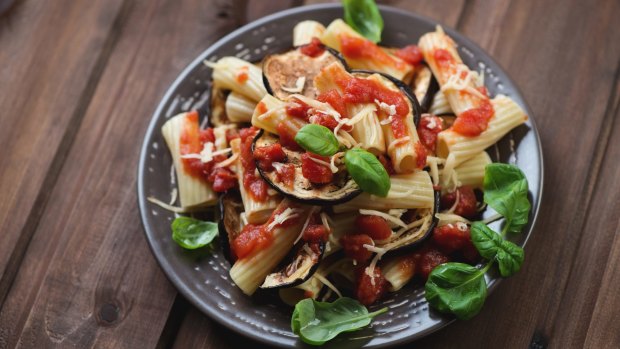
Pasta alla Norma, a Sicilian dish with eggplant and tomato.Credit: Shutterstock.com
"Come around this way," says McNeil, leading us to the Duomo's northern wall, facing the Via Minerva. From this angle, a hidden truth is revealed: the cathedral's Norman walls are supported by massive Doric columns, remains of an ancient Greek temple. That is not the only clever bit of re-purposing engaged in by the Duomo's builders. Inside the cathedral, McNeil points out that the baptismal font is actually a Greek marble krater, or wine jug.
While Siracusa's scenic streets are packed with gems – in addition to Greek ruins and Norman cathedrals, there are Swabian forts, baroque fountains, and even a canvas by Caravaggio – Sicily's most atmospheric city must surely be Palermo. Here more than anywhere else you can follow the intertwining traces left behind by successive civilisations: from the narrow medina-style warren of the old Arab quarter, Kalsa, to the eye-catching Quattro Canti square, an extraordinarily elegant example of baroque city planning.
GARDEN OF EARTHLY DELIGHTS
Among Palermo's most intriguing relics is something wholly unexpected: 800-year-old pleasure gardens laid out in typical Islamic style. Our visit to what remains of La Zisa, a pleasure garden that sits near the heart of today's city centre, is a revelation. The walled hunting park where Sicily's rulers relaxed in summer, holding banquets in tented pavilions, was a tranquil retreat, with a central fountain fed by a series of canals, alive with the aromas of scented plants.
Just one building still stands. Centuries of abandonment have eroded much of its decorative detailing, but what is left gives an idea of how glorious it must once have been. The walls boast glittering mosaics featuring peacocks picking dates from palms and archers taking aim at birds in a tree; the doorways are crowned with exquisite muqarnas, the typically Islamic vaulting shaped like a honeycomb.
The most remarkable thing about these pleasure gardens is that they were not built by the Arabs who ruled Sicily for more than 200 years; rather, they were the work of the Norman invaders who chased them from the island. The Normans, who ruled Sicily from 1091, first as counts and then as kings, are among the most colourful rulers of medieval Europe, and early multiculturalists. Having taken over an island that consisted of a patchwork of cultures – including Muslim Arabs, Byzantine Greeks and Jews – they decided to make the best of what they had. Arab bureaucrats retained their jobs, and Arabic remained one of the languages of the government, along with Latin and Greek.
This was more than just pragmatism at work. The Normans had a genuine appreciation for Islamic aesthetics, as the existence of pleasure gardens such as La Zisa – commissioned by the Norman King William I – suggests. At a time when Islamic and Christian forces were clashing everywhere from Spain to the Holy Land, Sicily's rulers developed a distinctive Arab-Norman aesthetic. This unique visual culture has been recognised by UNESCO, with no fewer than nine separate buildings included in the World Heritage Listing for Arab-Norman Palermo.
Perhaps most astonishingly, the Normans even used Islamic techniques in their own Christian churches. One of the loveliest examples is the Palatine Chapel in the Palazzo Reale, Palermo's ancient power centre.
WHERE EAST MEETS WEST
The Palatine Chapel is a jewel box of a building, one that draws on Byzantine as well as Islamic influence. It seems to glow from within thanks to the shimmering Byzantine mosaics wrapped around the walls. Set against a glittering golden backdrop, the mosaics depict haloed saints and multi-winged angels, as well as Biblical figures from Adam and Eve to Noah on his ark.
By comparison, the chapel's wooden ceiling appears, at first glance, to be almost drab. "Take a closer look," McNeil urges us. When we do, we see each of the star-shaped polygons set into the ceiling is decorated with vividly painted scenes. There are dancing girls, hunting scenes, musicians, gamblers: all images with a decided Middle Eastern influence. Those same influences can be seen in the muqarnas that surround the wooden ceiling.
The Palatine Chapel is just the teaser for what may be Sicily's most dazzling building: the cathedral of Monreale, located 15 kilometres outside Palermo. Built in the 12th century by King William II, the cathedral's mosaics have no equal, according to McNeil: "They are better than those in [Venice's] St Mark's," he says. With more than 6000 square metres of mosaics slathered over almost every surface, it is hard to know where to look first. From the vaulted ceilings, myriad saints and images gaze down; along the walls, beautifully crafted scenes from the Old and New Testament unfold. What is striking is the vividness of the depiction, from a guilty-looking Adam and Eve in the Garden of Eden to the reluctant animals being coaxed onto a very crowded Ark by Noah and his family.
Don't leave without stopping by the lovely Benedictine cloister right next door. The lush garden is surrounded by an arcaded portico, each of its 228 columns a minor masterpiece. Again, Islamic influences are evident in the elaborate patterns of stripes and stars that decorate many of the columns; the richly carved capitals, featuring plants, animals and Biblical scenes, are just as arresting.
Ute Junker travelled as a guest of Finnair and Martin Randall Travel.
SICILY MUST-SEES
Make sure your Sicily itinerary includes these highlights.
PALERMO
From grand palazzi and elegant squares to warren-like neighbourhoods, from the ornate cathedral to the macabre Capuchin catacombs, Palermo is a city of many moods.
SIRACUSA
This ancient seaside city is packed with sights, but nothing beats the joy of wandering its pretty streets at random just to see what lies around the next corner.
PIAZZA ARMERINA
Just outside this small inland town lies an ancient Roman villa that boasts some of Europe's most magnificent mosaic floors.
MONREALE
Cathedrals don't come any more dazzling than the Norman cathedral at Monreale, which features glittering mosaics and a lovely cloister.
NOTO AND CATANIA
A baroque building frenzy followed the devastating earthquake of 1693, with exquisite towns such as Noto and Catania arising from the ashes.
FEAST ON THESE
From arancini to cannoli, many so-called Italian classics trace their origins back to Sicily. Sink your teeth into some of these tastes of Sicily.
INVOLTINI SICILIANI
Sicilian cuisine features a number of rolls; these veal rolls, filled with onions, tomatoes, raisins and pine nuts, are a favourite.
PASTA ALLA NORMA
A Sicilian classic, this pasta is topped with fried eggplant, tomatoes, basil and ricotta salata.
SFINCIONE
Just like pizza only different, sfincione has a thicker, focaccia-style base, and is traditionally topped with tomato sauce, onions and caciovallo cheese.
PANE E PANELLE
This classic street food, chickpea fritters loaded onto a sesame bun, dates back to the days of Arab rule.
SICILIAN WINE
Red wine fans are likely to enjoy the fruity nero d'avola, while white wine drinkers should try the distinctive grillo and Greco varietals. If you enjoy a dessert wine, the honey-coloured passito is exquisite.
TRIP NOTES
MORE
FLY
Finnair offers connections to more than 100 European destinations and was named Best International Airline – Offline in the prestigious 2017 Australian Federation of Travel Agents National Travel Industry Awards for the fifth consecutive year. See finnair.com/au
STAY
The Hotel Villa Belvedere in Taormina is a charming family hotel set in verdant gardens, quietly situated just a short stroll from the city centre. The best rooms have a sea view. From $US185, villabelvedere.it
TOUR
Martin Randall's 13-day Civilisations of Sicily itinerary covers the entire island and visits Greek, Roman, Norman, Renaissance and baroque sites. Each tour is accompanied by an expert lecturer and a tour manager. From £4470, see martinrandall.com
Sign up for the Traveller Deals newsletter
Get exclusive travel deals delivered straight to your inbox. Sign up now.